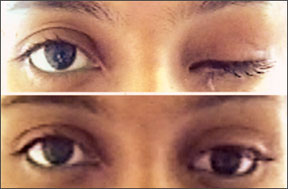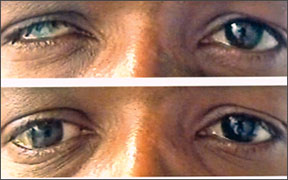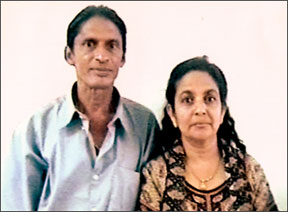Through artificial eyes
Custom made Ocular Prosthesis Eyes:
By Lakmal WELABADA
[email protected]
|

Before and after
|
Eyes narrate many things in life. Many poets both in the Eastern as
well as the Western world have written many beautiful verses about the
`eyes’ of beauties. `Just like the pupil of her eye, a mother looks
after her only child’; this was how they described the overflowing love
of a mother... But! Does everybody get blessed to have `eyes’? Eyes play
a big role in a human’s life as they attract you at a first glance.
Everybody is not gifted with perfect human organs. Hence, wigs,
dentures, padded or skinny dresses and so on are being used to cover up
their imperfections.
Likewise those who have deficiencies in their eyes too suffer
silently for not having an alternative to look `ok’... “Artificial eyes
cost a lot,” is the bewailing answer of many such disabled who have lost
both or either of their eyes by birth or many other tragic
circumstances.
B. P. D. Sunil Dayananda Wickremasinghe of Cosmetic Eye Laboratory at
Douglous Fernando Mawatha, Chilaw reveals his revolutionary secret
formula method to the public who shed tears for an eye. `Custom made
Ocular Prosthesis Eyes’ is his solution for it.
“`Prosthesis Eyes’ mean manually made artificial eyes for those who
have lost eyes by birth or later due to many reasons. As we use a
denture when we lose teeth, we use this artificial `eye-cap’ to cover
the eye area and to look near perfect,” says Wickremasinghe.
|

Before and after |
“This method is being practised in many countries. But only about 250
ocular technicians are in the world, as far as I assume. There’s no
institution to train this as a method professionally. I did a two years
research on this before I found the correct form,” claims Wickremasinghe.
An eye consists mainly of an eye ball (which fixes in the eye socket
with nerves and tissues), Scleral (the white colour part of the eye),
Cornea (the light circular shade of the dark part of the eye which
differs in colour and dimension, from person to person) and the Pupil
(the tiny round dark circle at the centre of the eye).
Due to many reasons people lose their eye sight, and in such times
they have to undergo surgery to remove their eyes. There are two steps
in surgical removal of an eye; Enucleation - the whole eye including the
eye ball, Scleral, Cornea and Pupil are removed. Evisceration - removal
of the damage part of the eye content.
“When the whole eye gets removed, a big eye socket would remain in
the eye area. In order to cover this up, one would buy an artificial
eye-cap and wear it as you do so with a denture. But what happens is,
this eye-cap (which can be bought from opticians) would get pushed up
giving an unappealing appearance.
The eye socket and eye-cap should be fitted very well, as otherwise
the eye area would fill with a discharge often. Even some clients who
come to us are unaware about it, until they remove it from their eyes.
Also an artificial eye would differ from one’s remaining eye due to
its proportion, colour and the dimensional errors. When we make an
artificial eye we try to make it exactly like the other remaining eye.
Even if one has to wear two Prosthesis eyes for both eyes (in a case
when both eyes are removed) both artificially made eyes should be fixed
well in the eye sockets,” says Wickremasinghe.
“A client with an Evisceration can be given an eye-cap easily as his
eye-ball remains inside, and only the outer cap (Scleral, Cornea and
Pupil) have to be made. But, when it comes to an Enucleation, the
eye-ball is also being removed.
|

B.P.D. Sunil Dayananada and Dr. (Mrs.) M.W. Marie Jacintha Silva |
In such circumstances, we have to install an eye-ball first,” he
says. Acrylic plastic (synthetic formula used for dentures) or
Hydroxyapatite (made of human bone powder) is used to make the eye-ball.
According to Wickremasinghe, the best formula is Hydroxyapatite as it
is however, an extraction of another human body, and is believed would
get adjusted better with the remaining tissues and nerves of the eye
socket.
“But, Hydroxyapatite eye-ball is expensive than Acrylic. The eye-ball
installation is a must which is done in a theatre by a surgeon. I do
only the eye-cap, the outer part which we call `Custom made prothesis
eye cap’,” says Wickremasinghe.
Question : Your `Prosthesis Eyes’ look so natural with tiny blood
vessels and a black Cornea and a Pupil. Does it make movements as a
natural eye?
Wickremasinghe : Yes. This is because, though the
eye-ball and the other contents are removed, tissues and nerves of
the eye would not be removed. When the brain emits signals the tissues
and nerves around the eye area support the artificially made eye-cap
also to make the movements. It’s so simple. Our eyes don’t move two
different directions, but towards one particular way at a time.
Likewise suppose one has to remove his one eye and he has to wear an
eye-cap on the removed one, his eye-cap will also make movements along
with the other eye. So, there won’t be much difference in the movements
of the two eyes. This method is the best method in these circumstances.
Question : What is the technique you use?
Wickremasinghe : First I take an impression (measurement) of the eye
while the client lies down on bed. Then I make a dummy according to the
measurements. I use Acrylic plastic (which is used for dentures) which
has no adverse reaction to the human body. .... to form the Scleral
covershell of the eye-cap.
Though Wickremasinghe tried to get down the equipment from India to
form the method, they had refused and offered him the artificially made
eyes only. So, he accepted the challenge and decided to find a technique
of his own.
After two years of research, Wickremasinghe managed to develop his
own method to make a `Prosthesis eye’, using Acrylic as the base and
`special paints’ to form the eye to look Sri Lankan. Wickremasinghe says
he can call himself as the only `Ocularist’ (a person who make
`Prosthesis Eyes’) in Sri Lanka.
“Dr. M. Wijetunga of Negombo Hospital is the only Oculo Plastic
Surgeon in Sri Lanka. The encouragement I have been getting from him is
immense. He has sent me many patients, and I have been able to fulfil
their need with the maximum effort,” he says. |
